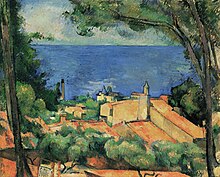Houses in L'Estaque
| Houses in L'Estaque |
|---|
| Georges Braque , 1908 |
| Oil on canvas |
| 73 × 60 cm |
| Kunstmuseum Bern, Bern
Link to the picture |
Houses in L'Estaque (French original title Maisons à l'Estaque ) is the title of an oil painting by the French painter Georges Braque from 1908, created in L'Estaque near Marseille . It is the image that first evoked the term “ cubes ” (see → Cubism ). The painting with the dimensions 73 × 60 cm is in the holdings of the Kunstmuseum Bern .
description
L'Estaque on the bay of Marseille was still a fishing village at the beginning of the 20th century, which the French painter Paul Cézanne had already chosen as a motif in his pictures. In contrast to some of Cézanne's paintings, Braque's painting does not show the sea. Leafy trees stand in close-up between several offset ocher-colored houses. In the foreground of the picture, a mighty tree trunk and its bare branches, starting from the center at an angle to the left, cut the field of view. Details such as the doors and windows of the houses, which are shown in a simplified cubic form, are missing.
history
At the beginning of 1907 Pablo Picasso prepared many studies and variations for the painting Les Demoiselles d'Avignon , which he finished in July. It is considered to be the image that laid the foundation for “cubist” thinking and ushered in the artist's period, often referred to as the “période nègre”. The name "période nègre", which led to misunderstandings, arose because Picasso was also inspired by African sculptures. At the end of the year, Braque visited Picasso in his studio and saw the picture that both confused and fascinated him. As a result, a friendship developed between the two artists, so that between September 1908 and May 1909 they saw each other almost every day. The mutual influence that would lead to Cubism had begun.
The great commemorative exhibition for Paul Cézanne was shown in the Paris Autumn Salon in 1907 . According to his own statement, the landscapes and still lifes of Cézanne shaped Braque's work and inspired him to travel to L'Estaque.
The picture Houses in L'Estaque was painted by Braque among others from the region in 1908; it occupies an important place in the history of art because it was the first image to be associated with the term “cubes” in public . After Braque was rejected in 1908 in the Salon d'Automne - or Herbstsalon - in Paris with his new paintings from L'Estaque, he exhibited them in November of that year in the gallery of the German gallery owner Daniel-Henry Kahnweiler, which opened in 1907 . The art critic Louis Vauxcelles , who had already thought of the term "Fauves", wild animals, when he saw works by painters such as Henri Matisse and André Derain at an exhibition in the Salon d'Automne in 1905 and who thus gave Fauvism its name wrote in Gil Blas about the exhibition at Kahnweiler: “Braque doesn't care about form; he simplifies everything, landscape and houses, into geometric schematic forms, into cubes ”. In the spring of 1909 he repeated his rebuke after an exhibition in the Salon des Indépendants , where Braque showed a landscape picture and a still life, and spoke of "péruvien cubisme" ( Peruvian cubism ), which quickly established the term cubism.
literature
- Anne Gantführer-Trier, Uta Grosenick (eds.): Kubismus , Benedikt Taschen Verlag GmbH, Taschen 25th anniversary special edition, 2nd edition 2007, ISBN 978-3-8228-2955-4 .
- Daniel-Henry Kahnweiler : The Way to Cubism . Verlag Gerd Hatje Stuttgart, first edition 1920.
- Florian von Heinze (editor): Art and architecture: 1000 questions and answers . Bertelsmann Lexikon Verlag, Gütersloh 2006, ISBN 978-3-577-07560-2 . ( Page 222, online )
- Siegfried Gohr : Pablo Picasso. Life and work. I do not search, I find . DuMont Literature and Art Verlag, Cologne 2006, ISBN 3-8321-7743-4 .
